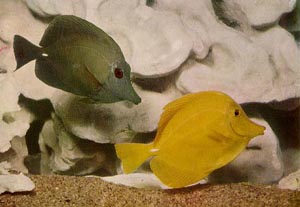Surgeonfishes

Yellow Surgeon, two color phases
photo by John Tashjian, Living Fishes of the World, p. 212
A surgeonfish has a tiny "knife" on each side of the fish, just in front of the tail (in the photo above, these are the small white areas on the side of each fish). There
are many different kinds of surgeonfish, and they come in many colors. Some change
color as they get older. For example, the blue tang surgeonfish is bright yellow when
young and becomes blue as an adult. The American Atlantic ocean surgeon changes
color to signal to other fish. For example, a scientist has observed an ocean surgeon
change to a dark olive-brown to tell other fish to start cleaning it. The scientist also
observed a surgeon that was annoyed by another fish change color as the angry fish
chased the other fish. Surgeonfishes use their "knives" to defend their territory. They
usually will not threaten any creature bigger than they are. Therefore, you are not
likely to be hurt by a surgeonfish unless you handle it. However, some careless
fisherman have learned that a surgeonfish cut can be quite deep and very painful.
What You Should Do
Observe the surgeonfishes but do not threaten them. If you are somehow cut by one:
1. Cover the cut in hot water (but not so hot that it will burn you) until the pain
starts to lessen. It may take 30 to 90 minutes for the pain to be relieved.
2. Remove any pieces of the blade. Scrub the wound with soap and water, and pour lots
of fresh water over it.
3. Do not tape or sew the wound closed.

